1993 CADILLAC FLEETWOOD traction control
[x] Cancel search: traction controlPage 10 of 386
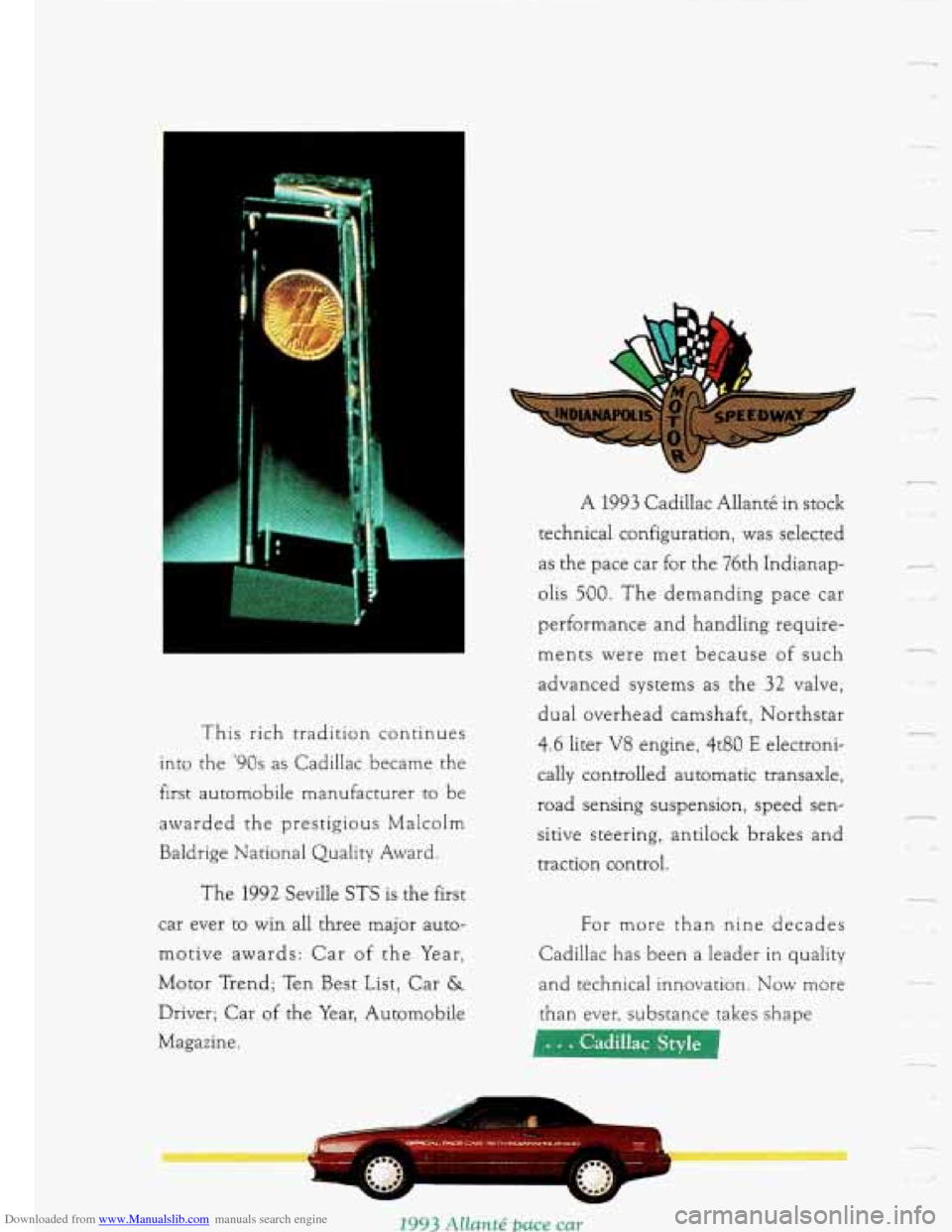
Downloaded from www.Manualslib.com manuals search engine This rich tradition continues
into the
‘90s as Cadillac became the
first automobile manufacturer to be
awarded the prestigious Malcolm
Baldrige National
Quality Award.
The
1992 Seville STS is the first
car ever to win all three major auto-
motive awards: Car of the Year,
Motor Trend; Ten Best List, Car
&a
Driver; Car of the Year, Automobile
Magazine.
V
A 1993 Cadillac AllantC in stock
technical configuration, was selected
as the pace car for the 76th Indianap-
olis
500. The demanding pace car
performance and handling require-
ments were met because
of such
advanced systems as the
32 valve,
dual overhead camshaft, Northstar
4.6 liter V8 engine, 4t80 E electroni-
cally controlled automatic transaxle,
road sensing suspension, speed sen-
sitive steering, antilock brakes and
traction control.
For more
than nine decades
Cadillac has been
a leader in quality
and technical innovation. Now more
than ever, substance takes shape
1
c_q
7,
U
Page 82 of 386

Downloaded from www.Manualslib.com manuals search engine passed. If you vehicle has the Remote Keyless Entry feature, just push
any button on the transmitter.
1
Leaving Your Whicle
If you are leaving the vehicle, take your keys, open your door and set the
locks from inside. Then get out and close the door.
T h
If your vehicle has a theft deterrent system, see “Universal Theft
Deterrent’’ in the Index. r I
d
Glove Box
The glove box is directly in front of the front passenger seat. To unlock
the door, insert the door key into the
lock cylinder and turn it to the left.
To lock the door, turn the key to the right and remove the key. The key
may be removed in the locked or unlocked position.
Traction Control Disable Switch
This feature is deleted
on Coach Builder
limousine and funeral
coach packages.
You’ll find the switch
in the glove box.
You will need to use this switch should
you get stuck in a snow bank and
can’t rock the vehicle out. To disable traction control, press the right end
of the switch until the yellow “TMCTION CONTROI? telltale light
comes
on. The system is reset the next time the ignition key is turned off.
r
U
c
1
c-
U
68
U
Page 117 of 386
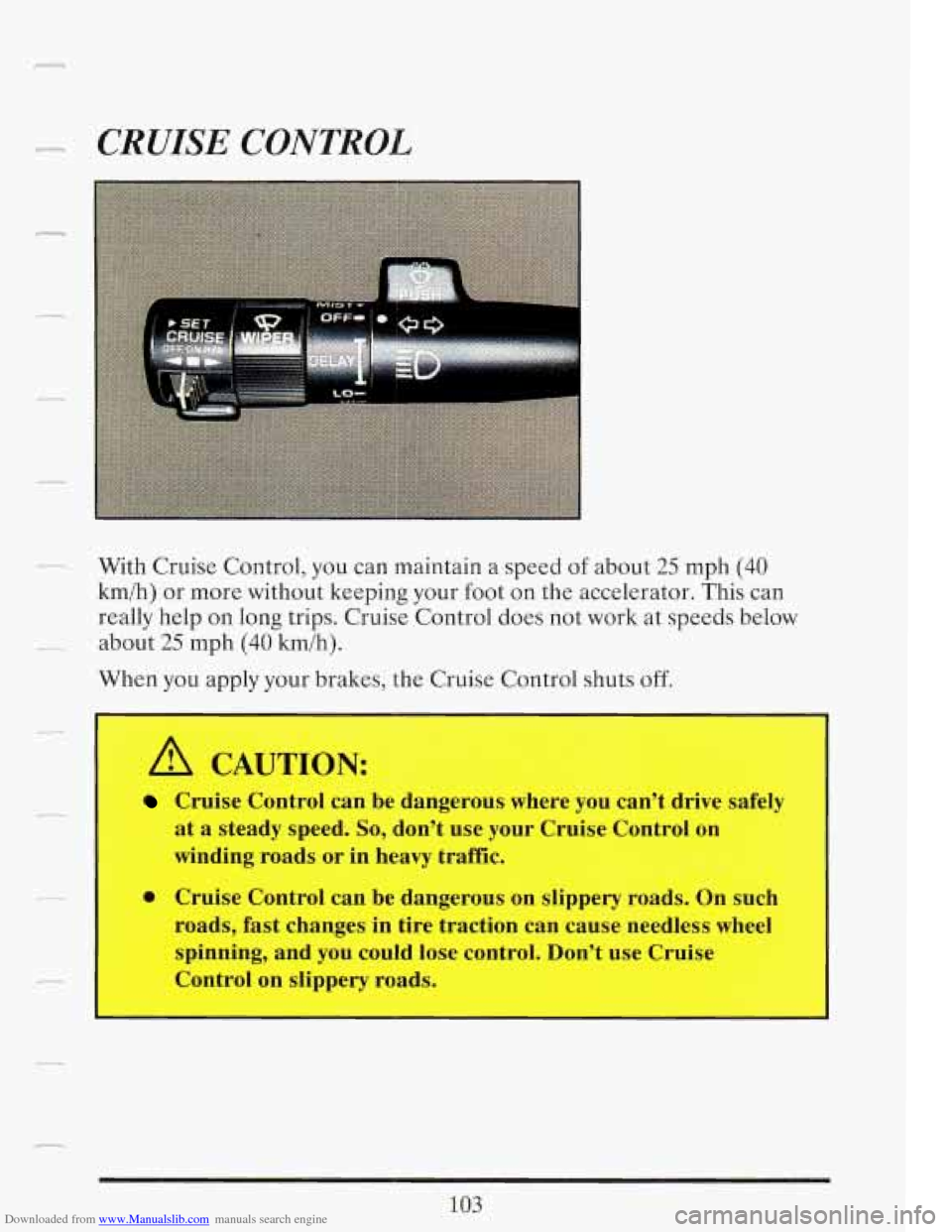
Downloaded from www.Manualslib.com manuals search engine CRUISE CONTROL
With Cruise Control, you can maintain a speed of about 25 mph (40
km/h) or more without keeping your foot on the accelerator. This can
really help
on long trips. Cruise Control does not work at speeds below
about
25 rnph (40 km/h).
When you apply your brakes, the Cruise Control shuts
off.
A CAUTION:
Cruise Control can be dangerous where you can’t drive safely
at a steady speed.
So, don’t use your Cruise Control on
winding roads or in heavy traffic.
0 Cruise Control can be dangerous on slippery roads. On such
roads, fast changes in tire traction can cause needless wheel
spinning, and you could lose control. Don’t use Cruise
Control on slippery roads.
103
Page 141 of 386
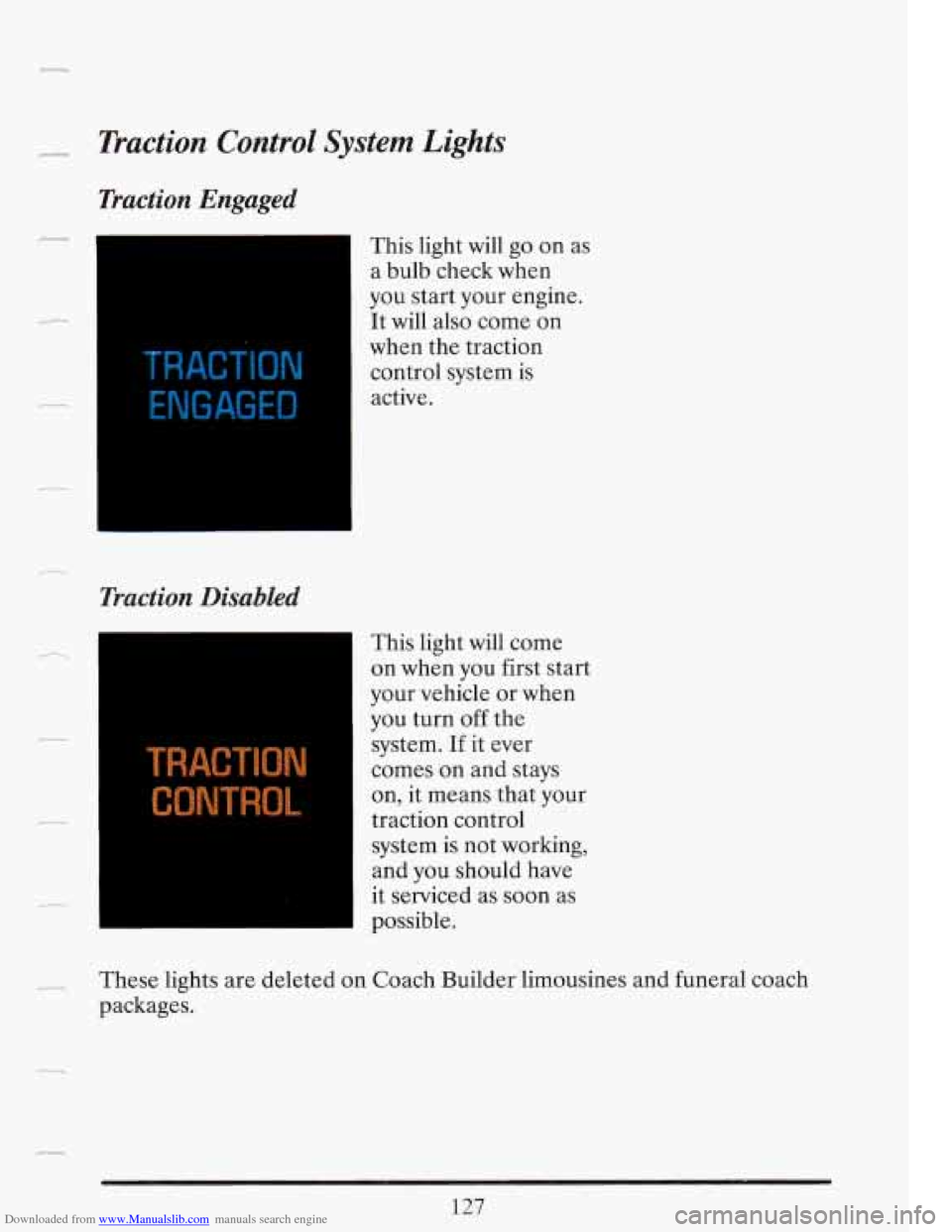
Downloaded from www.Manualslib.com manuals search engine *_* Traction Control System Lights
Traction Engaged
1
TRACTION
ENGAGED
Traction Disabled
This light will go on as
a bulb check when
you start your engine.
It will also come on
when the traction
control system is
active.
This light will come
on when you first start
your vehicle
or when
you turn
off the
system. If it ever
comes on and stays
on, it means that your
traction control
system is not working,
and you should have
it serviced as soon as
possible.
These lights are deleted on Coach Builder limousines and funeral coach
packages.
Page 190 of 386

Downloaded from www.Manualslib.com manuals search engine Traction Control System
~ This feature is deleted
on Coach Builder
limousines and
funeral coach
packages. I
TRACTION
ENGAGED
Your vehicle has a traction control system that limits wheel spin. This is
especially useful in slippery road conditions. The traction control system
works at all speeds. It limits wheel spin by reducing engine torque by
closing the throttle and applying the rear brakes. You may feel the system
working, or you may notice some noise, but this is normal. You may also
feel the accelerator pedal push back against your foot.
I ~
i
TRACTION
I: I
The “Traction Control” warning light lets you know when there is a
problem with your traction control system, unless your system is turned
off. When this light is on,
you have no automatic wheel spin protection.
Adjust your driving accordingly. If you can’t get the light off after
recycling the ignition, have your car serviced.
n
u
c ‘I W
n
U
I
LrJ
-
L
..
r
1
L 7
I
UI
Page 191 of 386

Downloaded from www.Manualslib.com manuals search engine To limit wheel spin, especially in slippery road conditions, you should
always leave your traction control system on. But you can turn the
traction control system off
if you ever need to.
TRACTION
CONTROL
DISABLE
SWITCH
3
To turn the system off, press this switch. The “Traction Control” light will
come on and stay on. To turn the traction control system back on, you
must stop and turn off the ignition. Then restart the engine. The traction
control system automatically comes on whenever you start your vehicle.
-
Disc Brake Wear Indicators
Your Cadillac has front disc brakes and rear drum brakes.
-- Disc brake pads have built-in wear indicators that make a high-pitched
warning sound when the brake pads are worn and new pads are needed.
The sound may come and go or be heard all the time your vehicle is
.. - moving (except when you are pushing on the brake pedal firmly).
I
A CAUTION:
The brake wear warning sound means that sooner or later your
brakes won’t work well. That could lead to an accident. When
you hear the brake wear warning sound, have your vehicle
serviced. I
Page 193 of 386
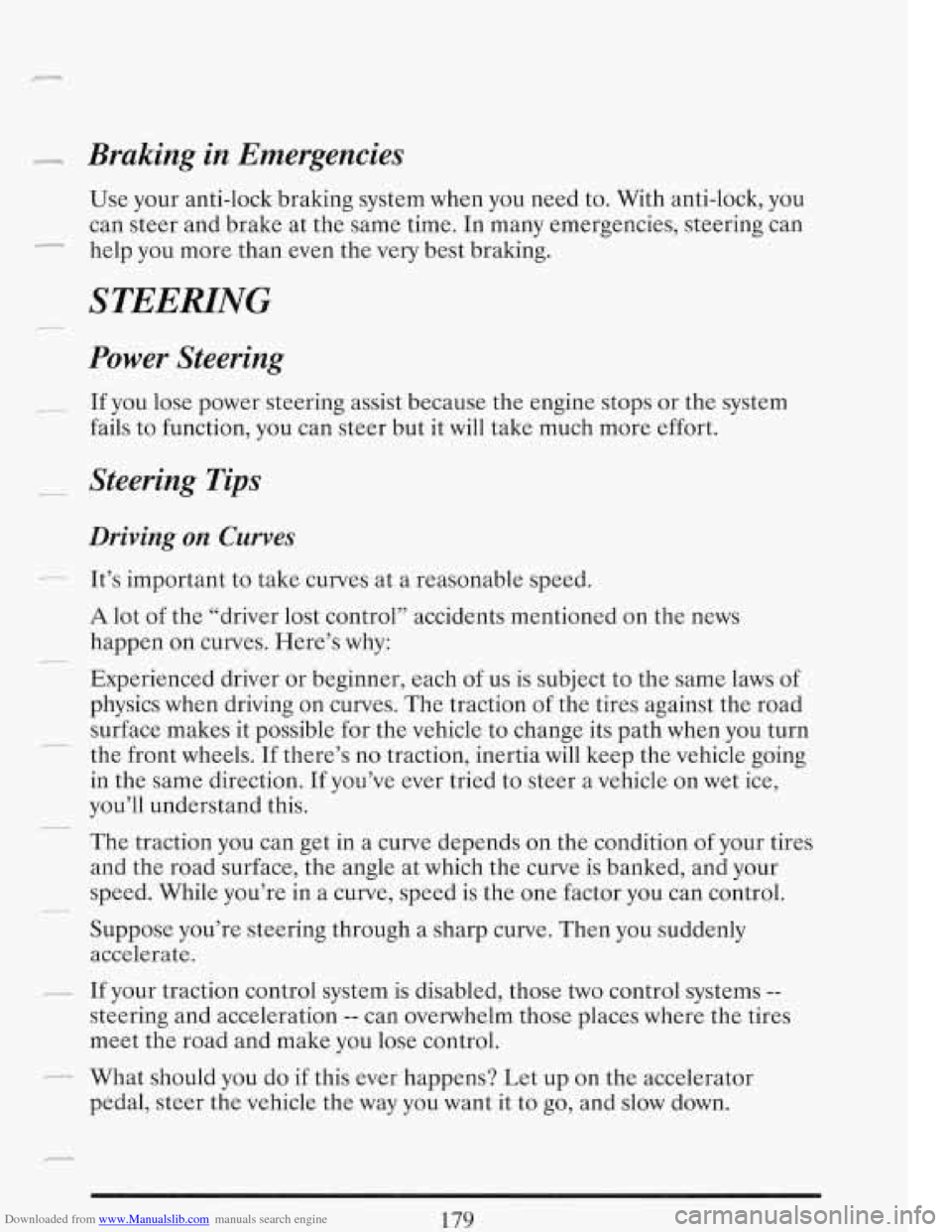
Downloaded from www.Manualslib.com manuals search engine Braking in Emergencies
Use your anti-lock braking system when you need to. With anti-lock, you
can steer and brake at the same time. In many emergencies, steering can
help you more than even the very best braking.
STEERING
Power Steering
If you lose power steering assist because the engine stops or the system
fails to function, you can steer but it will take much more effort.
Steering Tips
Driving on Curves
It’s important to take curves at a reasonable speed.
A lot of the “driver lost control” accidents mentioned on the news
happen on curves. Here’s why:
Experienced driver
or beginner, each of us is subject to the same laws of
physics when driving on curves. The traction
of the tires against the road
surface makes it possible for the vehicle to change its path when you turn
the front wheels. If there’s no traction, inertia
will keep the vehicle going
in the same direction. If you’ve ever tried to steer
a vehicle on wet ice,
you’ll understand this.
The traction you can get in a curve depends on the condition
of your tires
and the road surface, the angle at which the curve is banked, and your
speed. While you’re in a curve, speed is the
one factor you can control.
Suppose you’re steering through a sharp curve. Then you suddenly
accelerate.
If your traction control system
is disabled, those two control systems --
steering and acceleration -- can overwhelm those places where the tires
meet the road and make you lose control.
What should you do if this ever happens? Let up on the accelerator
pedal, steer the vehicle the way you want it to go, and slow down.
179
Page 198 of 386
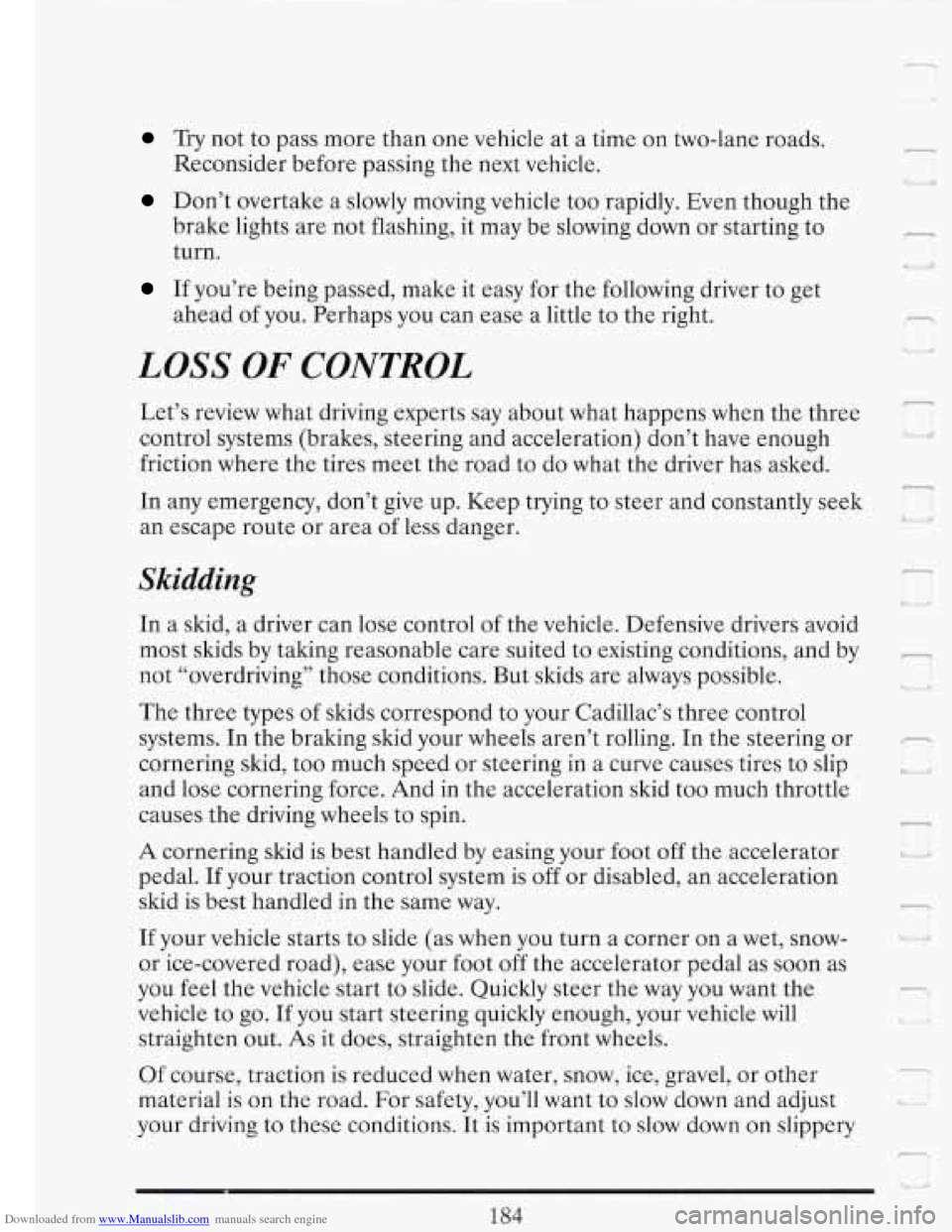
Downloaded from www.Manualslib.com manuals search engine Try not to pass more than one vehicle at a time on two-lane roads.
Reconsider before passing the next vehicle.
Don’t overtake a slowly moving vehicle too rapidly. Even though the
brake lights are
not flashing, it may be slowing down or starting to
turn.
If you’re being passed, make it easy for the following driver to get
ahead
of you. Perhaps you can ease a little to the right.
LOSS OF CONTROL
i
r
I/ U
Let’s review what driving experts say about what happens when the three
control systems (brakes, steering and acceleration) don’t have enough
’; I I
friction where the tires meet the road to do what the driver has asked.
r
In any emergency, don’t give up. Keep trying to steer and constantly seek
an escape route or area
of less danger.
-
le
Skidding
In a skid, a driver can lose control of the vehicle. Defensive drivers avoid
most skids by taking reasonable care suited to existing conditions, and by
._
not “overdriving” those conditions. But skids are always possible. < .,
The three types of skids correspond to your Cadillac’s three control
systems. In the braking skid your wheels aren’t rolling.
In the steering or
cornering skid, too much speed or steering in a curve causes tires to slip
and lose cornering force. And in the acceleration skid too much throttle
causes the driving wheels to spin.
A cornering skid is best handled by easing your foot off the accelerator
pedal.
If your traction control system is off or disabled, an acceleration
skid is best handled in the same way.
If your vehicle starts to slide (as when you turn a corner on a wet, snow-
or ice-covered road), ease your foot off the accelerator pedal as soon as
you feel the vehicle start to slide. Quickly steer the way you want the
vehicle to
go. If you start steering quickly enough, your vehicle will
straighten out.
As it does, straighten the front wheels.
Of course, traction is reduced when water, snow, ice, gravel, or other
material is on the road. For safety, you’ll want to slow down and adjust
your driving to these conditions. It is important to slow down on slippery
Lj
il t
1
-.
184